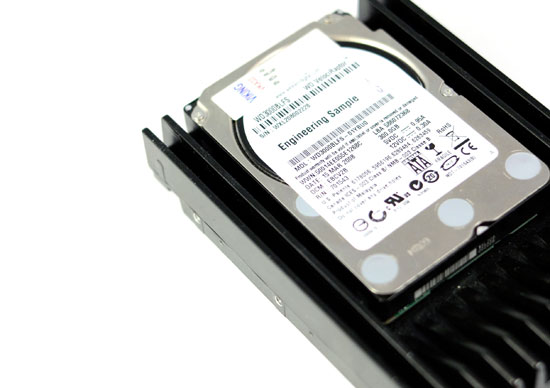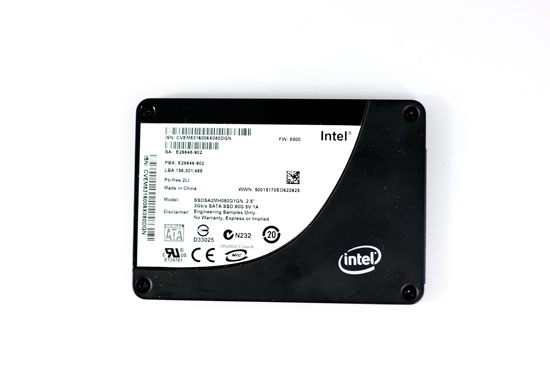The SSD Anthology: Understanding SSDs and New Drives from OCZ
by Anand Lal Shimpi on March 18, 2009 12:00 AM EST- Posted in
- Storage
Why You Should Want an SSD
For the past several months I’ve been calling SSDs the single most noticeable upgrade you can do to your computer. Whether desktop or laptop, stick a good SSD in there and you’ll notice the difference.
I’m always angered by the demos in any Steve Jobs keynote. Not because the demos themselves are somehow bad, but because Jobs always has a perfectly clean machine to run the demos on - and multiple machines at that. Anyone who has built a computer before knows the glory of a freshly installed system; everything just pops up on your screen. Applications, windows, everything - the system is just snappy.
Of course once you start installing more applications and have more things running in the background, your system stops being so snappy and you tend to just be thankful when it doesn’t crash.
A big part of the problem is that once you have more installed on your system, there are more applications sending read/write requests to your IO subsystem. While our CPUs and GPUs thrive on being fed massive amounts of data in parallel, our hard drives aren’t so appreciative of our multitasking demands. And this is where SSDs truly shine.
Before we go too far down the rabbit hole I want to share a few numbers with you.
This is Western Digital’s VelociRaptor. It’s a 300GB drive that spins its platters at 10,000RPM and is widely considered the world’s fastest consumer desktop hard drive.

The 300GB VelociRaptor costs about $0.77 per GB.
This is the Intel X25-M. The Conroe of the SSD world, the drive I reviewed last year. It costs about $4.29 per GB; that’s over 5x the VelociRaptor’s cost per GB.

The VelociRaptor is the dominant force in the consumer HDD industry and the X25-M is the svelte bullfighter of the SSD world.
Whenever anyone mentions a more affordable SSD you always get several detractors saying that you could easily buy 2 VelociRaptors for the same price. Allow me to show you one table that should change your opinion.
This is the Average Read Access test from Lavalys’ Everest Disk benchmark. The test simply writes a bunch of files at random places on the disk and measures how long it takes to access the files.
Measuring random access is very important because that’s what generally happens when you go to run an application while doing other things on your computer. It’s random access that feels the slowest on your machine.
| Random Read Latency in ms | |
| Intel X25-M | 0.11 ms |
| Western Digital VelociRaptor | 6.83 ms |
The world’s fastest consumer desktop hard drive, Western Digital’s 300GB VelociRaptor can access a random file somewhere on its platters in about 6.83ms; that’s pretty quick. Most hard drives will take closer to 8 or 9ms in this test. The Intel X25-M however? 0.11ms. The fastest SSDs can find the data you’re looking for in around 0.1ms. That’s an order of magnitude faster than the fastest hard drive on the market today.
The table is even more impressive when you realize that wherever the data is on your SSD, the read (and write) latency is the same. While HDDs are fastest when the data you want is in the vicinity of the read/write heads, all parts of a SSD are accessed the same way. If you want 4KB of data, regardless of where it is, you’ll get to it at the same speed from a SSD.
The table below looks at sequential read, sequential write and random write performance of these two kings of their respective castles. The speeds are in MB/s.
| Sequential Read (2MB Block) | Sequential Write (2MB Block) | Random Write (4KB Block) | |
| Intel X25-M | 230 MB/s | 71 MB/s | 23 MB/s |
| Western Digital VelociRaptor | 118 MB/s | 119 MB/s | 1.6 MB/s |
If you’re curious, these numbers are best case scenario for the VelociRaptor and worst case scenario for the X25-M (I’ll explain what that means later in the article). While the VelociRaptor is faster in the large block sequential writes look at the sequential read and random write performance. The X25-M destroys the VelociRaptor in sequential reads and is an order of magnitude greater in random write performance. If you’re curious, it’s the random write performance that you’re most likely to notice and that’s where a good SSD can really shine; you write 4KB files far more often than you do 2MB files while using your machine.
If the table above doesn’t convince you, let me share one more datapoint with you. Ever play World of Warcraft? What we’re looking at here is the amount of time it takes to get from the character selection screen into a realm with everything loaded. This is on a fully configured system with around 70GB of applications and data as well as real time anti-virus scanning going on in the background on every accessed file.
| WoW Enter Realm Time in Seconds | |
| Intel X25-M | 4.85 s |
| Western Digital VelociRaptor | 12.5 s |
The world’s fastest hard drive gets us into the game in 12.5 seconds. The Intel X25-M does it in under 5.
SSDs make Vista usable. It doesn’t matter how much background crunching the OS is doing, every application and game launches as if it were the only thing running on the machine. Everything launches quickly. Much faster than on a conventional hard drive. If you have the ability, try using your system with a SSD for a day then go back to your old hard drive; if that test doesn’t convince you, nothing will.
That’s just a small taste of why you’d want an SSD, now let’s get back to finding a good one.










250 Comments
View All Comments
Jamor - Wednesday, March 18, 2009 - link
The best tech article I've ever read, and I've read a few.haze4peace - Wednesday, March 18, 2009 - link
Wow, excellent article and so much useful information in an easy to understand way. I have just recently been paying attention to SSDs and thanks to this article I am armed with the information to make the correct choice for my needs. Thanks AnandTech, its the deep and honest articles like these that keep me coming back for more.Alseki - Wednesday, March 18, 2009 - link
I just registered then simply to say, great article. Really informative and enjoyable to read.alexsch8 - Wednesday, March 18, 2009 - link
Anand,Thank you for this article, very informative.
Looking at the example you are giving with your self-manufactured SSD drive: If I save the DOC I use up a page. Based on what you are saying, if I make a change to that DOC, it would then be saved in the next page instead of overwriting the existing page? If that is true, then the File Allocation system (FAT or MFT) itself would contribute quite a bit to the 'filling up of pages' phenomena. Could you elaborate if the proposed file system for SSD addresses this?
Ytterbium - Wednesday, March 18, 2009 - link
Fantastic article, shame that the vendors blacklisted you for telling the truth and OCZ rock for working so hard to address issues.I'll be ordering my Intel SSD soon, I'll defintly consider the Summit when it comes out for my encoding rig as there sequental writes matter to me.
mindless1 - Wednesday, March 18, 2009 - link
Great even, but I've have to disagree with the significance of the passage that suggested the Indilinx controller makes data loss as bad on those SSD as on a conventional hard drive.The primary cause of data loss is mechanical or component failure, not power loss. If we want to consider power loss, it's not just the drive which is prone to lose data, the entire system memory suffers far more data loss than that.
Further, a sufficiently sized supercapacitor should keep the drive operating for a period of time beyond when the rest of the system would be operational, it could be sufficient for the controller to finish writing to flash all received data (or just use an UPS, that's what they're for?).
Second, I can't believe that OCZ only tests designs with HDTach and Atto, I think it more likely they knew of the problem but didn't expect anyone to find it so quickly, and felt the higher sequential speeds made it more marketable. This makes me feel that manufacturers, then online sellers should differentiate their drives with a standardized random read/write score.
What would be really nice is if the Indilinx based SSDs had an application available, similar to a HDD acoustic management bit changing app, that lets the owner set their own preference for IO versus sequential read performance.
gomakeit - Wednesday, March 18, 2009 - link
This is by far the BEST article on SSD I've ever read! Great job anand and yes I read every single word of it!MagicPants - Wednesday, March 18, 2009 - link
Don't they ever try using their own devices? One second of latency should slap any user in the face. It should be very easy for a manufacturer to build a system with their new technology put it in front of people and see what happens, but apparently they're not doing this.They wait for reviewers to do the work for them and then get upset when they find a problem.
What the manufacturers should be taking away from this article is:
1) Try your competitor's products
2) Try your own products
3) Try them in real life as opposed to synthetic tests
4) Compare everything you've tried and market the performance that matters
7Enigma - Thursday, March 19, 2009 - link
But that would make sense....and we know marketing rarely does.paulinus - Wednesday, March 18, 2009 - link
That art is great. Finally someone done ssd test's right, and said loud what we, customers, can get for that hefty pricetags.I've supposed that only choices are intel and new ocz's. Now I know, and big kudos for that.
Just need a bit more $$ for x25-m, it'll be ideal for heavy workstation use, and biggest vertex'll replace wd black in my aging 6910p :)